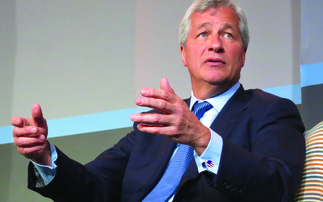
What are the dynamics driving yields and what's your perspective on it?
After a tumultuous 2022, the 2-year Treasury yield is at levels not seen in a decade and a half. The catalyst was higher- and stickier-than-expected inflation and major uncertainty about the pace and magnitude of central bank tightening. Global markets were quite brutal. It was the great valuation reset. Now income is back in fixed income. If you compare bond yields to the S&P earnings yield, fixed income looks materially more attractive than equities. Going forward,
there are many reasons to be more constructive on fixed income. Starting yields are substantially higher, which is critical in shaping return expectations. We believe that a lot would have to go wrong for fixed income to not do well going forward, which is a really good position to be in.
However, risks are still present.
What are investors worried about? How should they be thinking about fixed income?
Number one, aggressive central banks. While that risk may diminish as we get closer to the finish line, it's still a risk. However, let's put today's risk into context. Going from a 5% Fed funds rate to 6% is very different than going from a 1% Fed funds rate to 5%. Central banks are still talking tough. The European Central Bank (ECB) is probably the most vocal at this point.
Fixed income investors don't like inflation, and it looks a bit stickier than we thought. Then there's the "R" word — recession. If a recession is more severe than anticipated, spread becomes a risk as well.
That attractive yield that we've talked about, whether it's 5% in an investment-grade (IG) corporate bond or 8% in a high-yield bond, has two parts to it: interest rate and spread. If the US Federal Reserve stops hiking the Fed funds rate and pauses before they cut, rates may gravitate down, and spreads may move up. If credit sells off, how steep will it be? How much will spreads widen? If it's 300 basis points (bps), investors can potentially survive with a positive return in high yield. If it's 500 bps, now you're talking trouble. Duration and credit risk are a part of that story as well.
What else should investors be thinking about?
For economies like the US and parts of Europe, it takes about 12 to 24 months for higher rates to have an impact. We don't think the market is thinking about this. The weighted average cost of capital for every company on the planet just went up by a lot. While earning season hasn't ended, the numbers tell a story. Revenues are up across the board, but earnings are down. You don't have to be an economist to figure it out. Cost of goods, labour and interest expense have gone up. On top of that, tax rates for corporations are going up 2% to 3% this year as some tax provisions expire. Consumers are keeping revenues up. But companies are having trouble with the expense side, and margins and earnings are falling.
That's why we feel fixed income is well-positioned in a multi-asset portfolio environment. Given our concerns about profit margins, we believe there is downside risk to equities right now. Because of its valuation cushion, fixed income has historically had a defensive element. The 60% equity/40% bond, also known as balanced, portfolio may be back.
Do you think the marketplace puts too much emphasis on central bank actions given that economic growth drives long-term rates and the shape of the yield curve?
The longer the time horizon, we think the less central banks should matter. Near term, central banks are often the only game in town, last year for example. In the next market cycle, we think central banks will take more of a back seat than in the past. Markets will focus on long-term fundamentals, earnings strength, growth dynamics and so on and less on rates, inflation and central banks.
While central banks had a big impact last year, volatility resulted when the market had to reprice mistaken assumptions, namely that inflation was transient. The Fed realized they were behind the curve.
Half the problem, in our view, is the amount of narrative coming out of the Fed that drives bad assumptions, which creates volatility. There was a time when the Fed was less transparent. Now, more is shared, the market tries to digest it and gets some of it wrong. When the market is wrong, volatility spikes. It's contributing to short-term noise that investors act on. It gets harder to discern what's noise and what's material relevant information.
What fixed income sectors do you find more attractive or less attractive?
We've spent some time in Europe and find investment grade euro credit quite attractive. Spreads have corrected quite a bit. The outlook in Europe is improving. Micro fundamentals have started to bounce back, which is quite positive. While the ECB is talking tough, it's probably getting near the end of tightening, which we think is supportive for duration. There's a lot priced in on that curve. Putting everything together
— valuation, improving fundamentals and ECB nearing the end of its journey, the stars are aligning for European investment grade (IG) credit, as we see it.
Are US investment grade corporates as attractive as European? What about high yield?
We think they're attractive. But on a relative basis, European IG corporates are more attractive from a valuation perspective. But today's US IG has a 5% starting yield. It's got good duration if rates fall, technicals are decent and fundamentals are good.
While high yield is less attractive than US IG, we're finding high yield opportunities. However, we see many bonds with fake yield — companies that were kept afloat by Fed stimulus that may default. Given these risks, security selection is extremely important as the cost of picking the wrong company is high. In 2022, we saw aggregate demand that was too high and central banks working to reduce it. To do that, natural selection — company failures that were put on hold for many years — needs to resume. The weighted average cost of capital for companies in the S&P 500 Index jumped the most in four decades in 2022. Some companies won't be able to bear that higher cost, which will likely be material to risk markets. The cost
of capital could rise even higher if we enter a recession and the market prices spreads higher. To reissue debt, the cost would be incrementally higher. Again, we believe security selection and active management matter. While new issuance started strong, we don't expect issuance to be hitting records this year, especially if the cost of capital goes higher. That also gets at security selection. If there aren't as many bonds issued, the ability to source them in the secondary market or primary market becomes advantageous for a firm like MFS®.
Overall, we think fixed income is attractive on an absolute and relative basis to other asset classes, but caution or selection discretion is warranted, particularly in the deeper parts of the credit markets.
What are your thoughts on emerging market debt?
We think emerging markets (EM) are back after a horrendous 2022. The dollar looks like it hit a wall and that might persist going forward, which has historically been a positive for EM assets. China's reopening is also boosting investor sentiment. Global growth expectations are being revised upwards, not downwards, and the fear of a global recession is disappearing, which should ultimately benefit emerging markets.
Moreover, we seem to be in a world that we have outgrown physically. We're short on manufacturing capabilities, clean energy assets and materials, all of which are exported by EM countries.
What are your thoughts on the municipal sector?
Fundamentals look fairly good. Many municipalities were beneficiaries of COVID stimulus. State revenues and tax receipts have gone up for the past few years, even in 2020, and states and municipalities are flush with cash. Investment grade and high yield valuations and yields are great, relative to taxable and history. Technicals are the only thing that's amiss. Muni funds experienced one of the biggest and longest outflow cycles in history last year. The asset is retail dominated, and outflows are a major headwind. The cycle will probably end when the Fed pauses and investors stop fearing rate hikes. At that point, good fundamentals and yields may help reverse the outflow cycle and then investors could get a technical tailwind. We think it's an attractive asset class. Investors don't have the profit margin, capital and labour risks of corporates.
Low default rates, high recovery rates and good fundamentals and valuations. We just need the outflow cycle to turn.
What do you think will happen to high stock and bond correlation? Will it come down? Go up?
In terms of correlation, equities and fixed income generally have had opposite sign sensitivities to growth and unemployment — when growth declines, it's bad for equities and generally okay for bonds.
Conversely, they have the same sign sensitivities to inflation and fed funds rates. Last year, inflation and rate volatility sent that same sign sensitivity through the roof. However, if 2023 turns into a negative growth story, the correlation between fixed income and equity should come down.
Glossary of Terms
Basis point is one hundredth of one percent.
Bond yield is the amount of money, also known as the return, that an investor makes from the bond's interest, also called coupon, payment. Yield is calculated by dividing a bond's coupon by current market price.
Corporate bond is a debt obligation, like an IOU, sold by a company to investors. In return, the company promises to pay interest on the principal and return the principal by a set date.
Earnings yield equals the earnings per share of stock of a company for the previous 12 months divided by the current market price per share of a company. The S&P earnings yield is the sum of the underlying index companies' earnings divided by the S&P 500 Index price.
Fed funds rate is the target interest rate set by the Federal Reserve and is the rate at which commercial banks borrow and lend their excess reserves to other banks overnight.
High yield bond is a corporate bond issued by a company with weak financial position that has a greater chance of not paying interest or principal relative to an IG bond. These bonds receive lower ratings by credit rating agencies. The higher yield is used to compensate investors for the higher risk relative to investment-grade bonds.
Investment-grade (IG) corporate bonds are high quality bonds based on a company's solid financial position and are considered more likely to repay investors on time than lower quality bonds. These bonds receive higher ratings by credit rating agencies.
New issuance describes a bond that is registered and sold in a public market for the first time.
Spread is the difference in yield between different types of bonds of the same maturity. The spread generally shows the difference in risk between a Treasury bond and a corporate bond.
Starting yield is the amount of income that an investment such as a bond produces at the time it is bought.
Standard & Poors 500 Stock Index measures the broad U.S. stock market.
The views expressed are those of the author(s) and are subject to change at any time. These views are for informational purposes only and should not be relied upon as a recommendation to purchase any security or as a solicitation or investment advice. No forecasts can be guaranteed.
Unless otherwise indicated, logos and product and service names are trademarks of MFS® and its affiliates and may be registered in certain countries.
Distributed by: U.S. - MFS Investment Management; Latin America - MFS International Ltd.; Canada - MFS Investment Management Canada Limited. No securities commission or similar regulatory authority in Canada has reviewed this communication.
Please note that in Europe and Asia Pacific, this document is intended for distribution to investment professionals and institutional clients only.
Note to UK and Switzerland readers: Issued in the UK and Switzerland by MFS International (U.K.) Limited ("MIL UK"), a private limited company registered in England and Wales with the company number 03062718, and authorised and regulated in the conduct of investment business by the UK Financial Conduct Authority. MIL UK, an indirect subsidiary of MFS®, has its registered office at One Carter Lane, London, EC4V 5ER. Note to Europe (ex UK and Switzerland) readers: Issued in Europe by MFS Investment Management (Lux) S.à r.l. (MFS Lux) - authorized under Luxembourg law as a management company for Funds domiciled in Luxembourg and which both provide products and investment services to institutional investors and is registered office is at S.a r.l. 4 Rue Albert Borschette, Luxembourg L-1246. Tel: 352 2826 12800. This material shall not be circulated or distributed to any person other than to professional investors (as permitted by local regulations) and should not be relied upon or distributed to persons where such reliance or distribution would be contrary to local regulation; Singapore -
MFS International Singapore Pte. Ltd. (CRN 201228809M); Australia/New Zealand - MFS International Australia Pty Ltd (" MFS Australia") holds an Australian financial services licence number 485343. MFS Australia is regulated by the Australian Securities and Investments Commission.; Hong Kong - MFS International (Hong Kong) Limited ("MIL HK"), a private limited company licensed and regulated by the Hong Kong Securities and Futures Commission (the "SFC"). MIL HK is approved to engage in dealing in securities and asset management regulated activities
and may provide certain investment services to "professional investors" as defined in the Securities and Futures Ordinance ("SFO").; For Professional Investors in China - MFS Financial Management Consulting (Shanghai) Co., Ltd. 2801-12, 28th Floor, 100 Century Avenue, Shanghai World Financial Center, Shanghai Pilot Free Trade Zone, 200120, China, a Chinese limited liability company registered to provide financial management consulting services.; Japan - MFS Investment Management K.K., is registered as a Financial Instruments Business Operator, Kanto Local Finance Bureau (FIBO) No.312, a member of the Investment Trust Association, Japan and the Japan Investment Advisers Association. As fees to be borne by investors vary depending upon circumstances such as products, services, investment period and market conditions, the total amount nor the calculation methods cannot be disclosed in advance. All investments involve risks, including market fluctuation and investors may lose the principal amount invested. Investors should obtain and read the prospectus and/or document set forth in Article 37-3 of Financial Instruments and Exchange Act carefully before making the investments.













